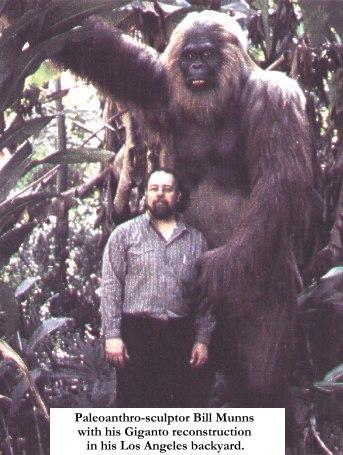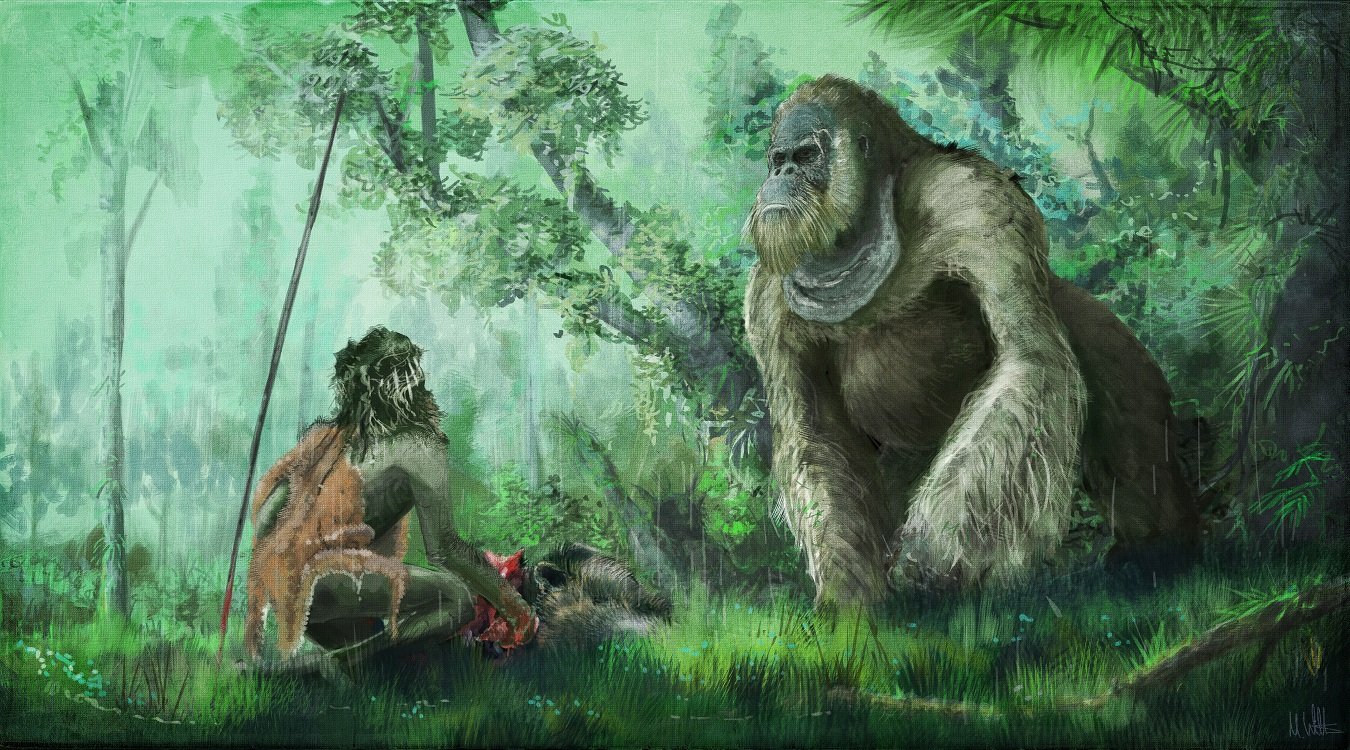
Frank Frazetta’s depiction of some humanoid, yet non-human, apes.
Of the world’s cryptids, two types recur all over the world. The first is the lake monster, usually with a long neck and humped body. The second is the upright ape, collectively called Bigfeet, for the sake of clarity. Apes recognized by science are limited to Africa and a few islands in Asia, but Bigfeet are found everywhere. The most famous Bigfeet are from North America, where no apes have ever been known to live besides humans, and they’re even seen in Australia, which never had primates at all until humans arrived.
These apes have a lot of variation on a few core features. The majority of them are fully covered in thick hair, usually described as brown but sometimes black or even orange like an orangutan. The “classic” Bigfoot is taller on average than humans, ranging from 6 to 8 feet in most sightings, while others are closer to a regular human size or even significantly shorter, such as the Orang Pendek of Sumatra. This, coupled with their wide geographic range, leads many to suspect that there are multiple origins for these upright apes, rather than just one. The question is, what could those origins be?

Danuvius guggenmosi, Velizar Simeonovski
Bipedal apes are actually more common in the fossil record than you might think. In the early days of Biological Anthropology (the study of the biological aspects of humans, including their evolution), it was thought that human evolution started with the brain, developing great intelligence before eventually evolving bipedalism. Fossils in Africa, such as Australopithecus afarensis, proved the opposite; human ancestors first developed the ability to walk on two legs, then only later grew the huge brains and intelligence of modern humans. This lineage was pushed further back by later finds, until the most recent suggesting that the ancestors of Africa’s modern apes might have been bipedal.
Danuvius guggenmosi is an ape that lived about 11 and a half million years ago, in what is now Bavaria. Europe was at the time much warmer and roamed by animals we would today see as African, such as lions, elephants, and several species of apes. Danuvius is not completely known, but its limb bones survived to tell an interesting story. According to Tracy L. Kivell, it “combines the adaptations of bipeds and suspensory apes”, meaning that it had adaptations for swinging and climbing, but also for walking on two legs in the trees. Its legs were adapted to be held directly under the body, keeping the ape upright. 11 million years is plenty of time to spread and adapt to many niches across the world. We already know that they split into chimps, gorillas, and humans, so why not Bigfoot?

Yeti Footprint, Eric Earle Shipton
Well, the split likely couldn’t be so early, going by supposed Bigfoot footprints. While they do sometimes show very different proportions to modern human footprints, they still clearly show feet that are adapted to terrestrial travel, with all of their toes facing forwards. Danivius still had a foot like modern chimps and gorillas, with an extended big toe that they used to grip branches as they walked. So when did this feature get lost?
The exact moment of the modern foot’s emergence is unknown. Earlier human species had feet slightly different than our own, but by about 3.6 million years ago, we have good evidence of apes leaving human-like footprints. These would be the Laetoli tracks, left by a few members of the species Australopithecus afarensis, known best as the species that “Lucy” belonged to.

One of the earliest terrestrial, bipedal apes.
So this brings things a lot more recent. If Bigfoot is descended from our lineage, it most likely split off after 3.5 million years ago. However, the Australopiths still have two factors that separate them from how Bigfoot is classically described. First, Australopithicus afarensis was still very arboreal, with shoulder joints like a modern ape, letting it climb better than a modern human. Being small apes, they almost certainly slept off of the ground for safety’s sake. Almost no modern Bigfoot sighting mentions any climbing ability, which is perhaps explained by the sheer size of the animals, forbidding them from climbing all but the sturdiest of trees.
The second oddity comes when we talk about body hair. While usually portrayed with chimpanzee-like hair, Australopithicus afarensis might have actually been nearly naked like a modern human. How would we know? Well, most mammals and birds, animals with soft, fuzzy coverings, play host to one species of lice each, which lives on their entire body. Humans instead have two species of lice, living on different parts of their body. This is because they had totally different origins and are kept apart by the relatively bare skin across most of their bodies.
Head lice are related to chimpanzee lice and split at the same time we did, but pubic lice split off from gorilla lice only 3-4 million years ago. This suggests that their bodies were already mostly hairless, leaving their original lice restricted to their head. If Bigfoot split off from here, their ancestors would have been as hairless as modern humans. It’s not a dealbreaker, as most Bigfoot are reported from more forested and colder climates, and so could have evolved a hairier coating again. It’s just an interesting issue to note.
No, the problem here is that we’re limiting the amount of time we can get Bigfoot, and we’ve still not got anything that close to them. All of these animals were tiny. That’s harder to explain away. Up until Homo erectus, we don’t get any animals even close to human sizes. And we’ve still never found any of these upright apes outside of Africa. And so, most Bigfoot believers don’t look to Africa for the ancestors of their humanoid, but Asia, where the mighty ape Gigantopithecus lived.

Gigantopithecus blacki was a massive ape, likely significantly larger than any modern primate. It’s hard to say exactly how large it was, because its only remnant is many teeth and a few lower jaws. This is, obviously, not a lot to go on, but enough that many early researchers thought it might be related to humans. This led to the obvious conclusion that it is bipedal, and thus resembled Bigfoot. This, rather than Australopithecus, is the most popular explanation for the origins of Bigfeet. Gigantopithecus was for a while so tied with Bigfoot in the popular consciousness that the image above represented how it was portrayed everywhere, not just in Bigfoot media.
That portrayal is almost certainly wrong. Modern analysis reveals proteomes (portions of proteins) closest to modern orangutans, suggesting that they are closest to the Asian great apes, not humans. This puts a pretty significant dent in the bipedal Gigantopithecus idea. Remember Danuvius guggenmosi? This find suggested that the ancestors of the modern African apes were bipedal in the trees. However, Gigantopithecus would have split off long before this means of locomotion existed, as evidenced by the fact that modern orangutans don’t knuckle walk like chimpanzees and gorillas. It doesn’t help that Gigantopithecus‘ likely weight would make it a lot more likely to walk on all fours, as humanity’s style of upright bipedalism becomes increasingly untenable at greater weights.

Probably much closer to how Gigantopithecus blacki actually looked (but it probably didn’t walk on its knuckles). Mark Witton
Even accounts of how big Gigantopithecus was probably don’t match up to the desires of the Bigfoot hunters. Early estimates were based only on teeth, and calculated weights in excess of twice that of a modern gorilla, who are usually about 400 pounds but can reach up to 590. Combined with the idea it was bipedal, this led to impressive heights ranging from 9 to 12 feet tall. More modern estimates suggest that Gigantopithecus did not vastly outweigh our largest modern apes, and in fact overlapped with them in size, ranging from about 450 to 660 pounds. These were not the King Kongs they are often portrayed as, instead staying well within the range we expect from large primates.
So where does that leave Bigfoot? Well, it doesn’t make it impossible. There are worse obstacles in the way of its existence than a lack of a decent fossil record. Many species are poorly attested as fossils. But it is telling that all bipedal, terrestrial apes besides humans were restricted to Africa, as per current evidence, and the Bigfoot hunter’s favorite apes fall through as Bigfoot candidates on closer inspection. So it seems, sadly, that despite everything, there are no Bigfoot fossils.
Want more prehistoric animals? Check out the articles below!

Well Gigantopithecus is just false advertising if it’s no bigger than your garden variety primate!
It was plenty big! Just not as big as we thought.